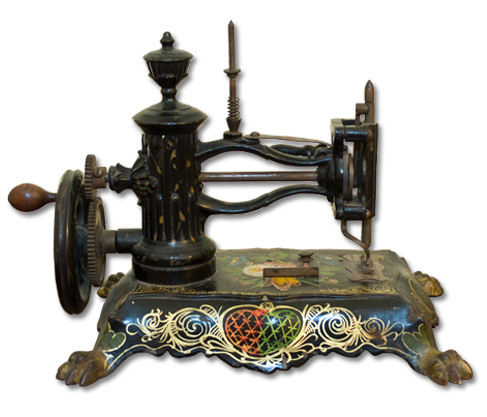
Mid-19th Century
America
Cast iron and paint
Eugene Field House Museum
Descriptive Detail
Brightly painted with animals and flowers on its bed, this small black cast-iron sewing machine sits on an elaborately decorated pedestal. Its size makes us wonder how it was used. Could it have been a salesman’s working model? Perhaps a seamstress used it for mending or while traveling. Because this machine dates from the 1860s, it very likely doubled as or was a child’s sewing machine made specifically for young girls, who were expected to learn to sew at an early age. Machines that were intended to be marketed as a child's machine were often painted in a different color or, like this one, had floral motifs painted onto the body of the machine.
Local Historical Connections
Few inventions have proved as valuable to the world as that of the sewing machine. It ranks high on every list of great inventions and has freed women from drudgery as perhaps no other mechanical device in history. "Next to the plough" wrote Louis Antoine Godey in 1856, "this sewing machine is perhaps humanity's most blessed instrument." The sewing machine was also hailed as the Queen of Inventions, impacting both the domestic world and the commercial world. Before the sewing machine appeared, making clothing (or shoes, boots, gloves, etc.) was always done by hand. It was a labor-intensive and time-consuming process. In the Roswell Field household there would be a continuous need for mending and sewing especially when there two active and growing boys. There might well have been others besides the cook and the nanny who assisted with chores such as sewing.
National Historical Connections
Although some ready-made clothing was available as early as Roman times, until the late nineteenth century nearly all clothing was made in the home. According to Godey's Lady's Book, it took about fourteen hours to make a man's dress shirt and at least ten for a simple dress. A middle-class housewife spent several days a month making and mending her family's clothes even with the help of a hired seamstress. After the purchase of a sewing machine—and suitable training and practice—those hours dropped to one and a quarter hours for the shirt and one hour for the simple dress. The itinerant dressmaker was forced to find another way to make her living. In fact, the greater efficiency of the sewing machine made it possible for an enterprising housewife to "take in sewing" for extra money just as working-class women took in washing.
In the marketplace, sewing, which had always been farmed out as piecework to be done at home, could now also be done in contractors' shops or on salary in factories. The development of the sewing machine for factory use in the 1850s revolutionized the shoe and garment industries. Production moved from homes and small shops to large, machine-controlled environments dominated by impersonal managements. (St. Louis, with its access to leather, became a center for the shoe industry.) Although production increased and clothing prices fell, workers suffered loss of independence, lower wages, and often harsh working conditions. Hundreds faced unemployment. The situation became even worse when the addition of electric motors to the machines led to sweat shops. The ensuing social upheaval contributed to large-scale unrest, the organization of workers into unions, and eventually to the establishment of government standards for the workplace.
top^
next artifact}
|

|




